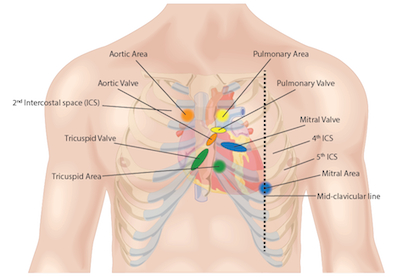心臓試験 II: 聴診
概要
ソース: Suneel Dhand、MD、医師、内科、ベス イスラエス ディーコネス メディカル センターに参加
心臓の音と正常と異常な心臓の音を区別する能力を聴く聴診器の使用中の能力は、任意の医師の必要不可欠なスキルです。胸に聴診器の正しい配置を閉じる心臓の弁の音に対応しています。心臓が 2 つの主要な音: S1 と S2 です。帽として最初の心臓音 (S1) に発生し、血液が心室に入る後に三尖弁 (房室弁) を閉じる。これは収縮期の開始を表します。第 2 心音 (S2) は、大動脈弁と肺動脈弁 (半月弁) が血液が心室収縮期の終わりに全身および肺循環システムを入力するを去った後を閉じるときに発生します。伝統的に、音が「lub-ダブ。」として知られています。
聴診器のチェスト ピースのダイヤフラムおよび鐘の部分を使って心臓の聴診を行います。横隔膜は、最もよく使用して僧帽弁閉鎖不全症、大動脈弁狭窄の雑音の高周波音 (S1 および S2) などに最適です。横隔膜は胸部の壁にしっかりと押す必要があります。最高の鐘 (S3 ・ S4 などの低周波音と僧帽弁狭窄症のつぶやきを送信します。ベルは、光の圧力を適用しなければなりません。
手順
1. 30-45 度に患者を置きます。
2. 確認対象エリアは露出し、決してガウンを聴診します。
3 定義された解剖学的ランドマーク (図 1) に聴診器を置きます。第 2 肋間スペースを見つけるため親指の良いルールは、このレベルでは、ルイ (胸骨柄結合) の角度を見つけることです。記載されているその他の肋間を検索するあなたの指で上下左右を触診します。

図 1。聴診面のランドマーク。
- 大動脈領域
- 2nd肋胸骨右縁に聴診器のダイヤフラムを配置します。これは大動脈弁の解剖学的ランドマークです。
- 大動脈弁の閉鎖を表す第
申請書と概要
スキップ先...
このコレクションのビデオ:

Now Playing
心臓試験 II: 聴診
Physical Examinations I
140.1K 閲覧数

身体検査の一般的なアプローチ
Physical Examinations I
117.6K 閲覧数

観察・検査
Physical Examinations I
95.1K 閲覧数

触診
Physical Examinations I
84.6K 閲覧数

パーカッション
Physical Examinations I
101.8K 閲覧数

聴診
Physical Examinations I
62.3K 閲覧数

身体検査中に患者の服装の適切な調整
Physical Examinations I
83.5K 閲覧数

血圧測定
Physical Examinations I
108.9K 閲覧数

バイタル サインの測定
Physical Examinations I
115.0K 閲覧数

呼吸試験 i: 検査と触診
Physical Examinations I
157.5K 閲覧数

呼吸試験 II: 打診と聴診
Physical Examinations I
213.1K 閲覧数

心臓試験 i: 検査と触診
Physical Examinations I
176.7K 閲覧数

心臓試験 III: 異常な心臓の音
Physical Examinations I
91.9K 閲覧数

末梢血管検査
Physical Examinations I
68.8K 閲覧数

連続波ドップラーを使用して末梢血管検査
Physical Examinations I
38.6K 閲覧数
Copyright © 2023 MyJoVE Corporation. All rights reserved